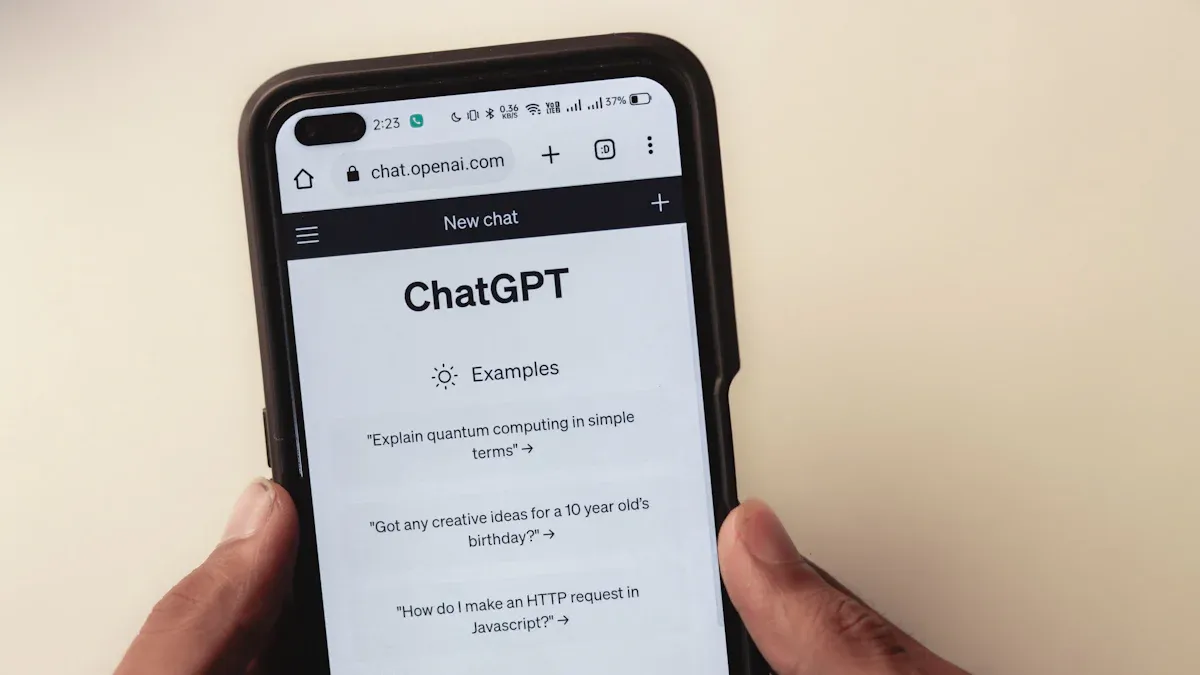How to Add ChatGPT to Your Website in Simple Steps

Imagine the possibilities when you add ChatGPT to my web site—a tool that tirelessly enhances user experience while saving time and resources. Adding ChatGPT to your website isn’t just about answering questions; it’s about fostering meaningful interactions. Businesses like ShopEase have achieved faster response times and happier customers by integrating ChatGPT for FAQs and order tracking. Emirates Vacations even increased engagement by 87% with personalized travel suggestions. Whether it’s providing 24/7 customer support or guiding visitors through the sales funnel, ChatGPT-powered chatbots can revolutionize how users interact with your site. Ready to add ChatGPT to my web site and elevate user engagement? Let’s dive in.
Key Takeaways
Add ChatGPT to make your website more fun and useful.
Get API access from companies like OpenAI to begin setup.
Adjust ChatGPT’s replies to match your brand’s voice and style.
Check how the chatbot works often to find ways to improve.
Keep data safe and follow rules to earn users’ trust.
Prerequisites for ChatGPT Integration
Before you dive into integrating ChatGPT into your website, it’s essential to prepare a few things. These prerequisites will ensure a smooth and efficient setup process.
Obtain API Access
Sign up for OpenAI or Newoaks AI
The first step is to create an account with a provider like OpenAI or Newoaks AI. Once you’ve signed up, navigate to the API section of your account dashboard. Here, you can generate an API key, which acts as a unique identifier for your integration.
Generate and secure your API key
After generating your API key, make sure to store it securely. Treat it like a password—don’t share it publicly or expose it in your website’s code. A secure API key ensures that only authorized users can access your ChatGPT integration.
Technical Setup
Ensure your website supports API integration
Check if your website’s platform supports API integration. Most modern platforms do, but it’s always good to confirm. If you’re using a custom-built website, ensure your server infrastructure can handle API requests.
Verify compatibility with programming languages like JavaScript or Python
You’ll need a programming language to connect your website to the ChatGPT API. Popular choices include:
JavaScript: Great for its versatility and ability to handle asynchronous data efficiently.
Python: Known for its simplicity and frameworks like Flask, which make API integration quick and easy.
Java: Ideal for large-scale projects due to its scalability and strong typing.
Choose the language that best fits your website’s existing setup and your team’s expertise.
Tools and Resources
Use a code editor and hosting platform
To integrate ChatGPT, you’ll need a reliable code editor like Visual Studio Code or Sublime Text. These tools make it easier to write and debug your code. Additionally, ensure your website is hosted on a platform that supports API calls.
Have a basic understanding of APIs and web development
While you don’t need to be a coding expert, a basic understanding of APIs and web development is crucial. Familiarize yourself with concepts like HTTP requests, JSON formatting, and how APIs communicate with your website. This knowledge will make the integration process much smoother.
💡 Tip: If you’re new to APIs, consider exploring beginner-friendly tutorials or documentation provided by OpenAI. These resources can help you get up to speed quickly.
By completing these prerequisites, you’ll set a strong foundation for integrating ChatGPT into your website. Once you’re ready, you can move on to the actual setup process with confidence.
Step-by-Step Guide to Add ChatGPT to Your Website
Backend Setup
Install necessary libraries or SDKs
To get started with the backend, you’ll need to set up the infrastructure for the ChatGPT API. Follow these steps:
Install the required libraries or SDKs for your chosen programming language. For Python, you can use
pip install openai.Set up your environment by creating an OpenAI account and obtaining your API key.
Write code to connect to the ChatGPT API. Use Python or JavaScript to send requests to the API endpoint.
Configure roles for the AI module, such as system, user, and assistant roles, to define how ChatGPT interacts with users.
Test the backend setup to ensure smooth communication with the API.
💡 Tip: Regularly update your SDKs and libraries to maintain security and performance.
Configure API calls to connect with ChatGPT
To ensure seamless communication with the ChatGPT API, keep these best practices in mind:
Use a stable internet connection and a development environment that supports WebSocket connections.
Securely store your API key to prevent unauthorized access.
Optimize your code to reduce latency and improve response times.
Test your API calls thoroughly to handle errors and unexpected inputs effectively.
Frontend Development
Create a chatbot interface (e.g., chat window or button)
Designing the chatbot interface is a crucial step. Here are some key considerations:
Consideration | Description |
|---|---|
Clarity | Ensure the conversation flow is intuitive and easy to navigate. |
Guidance | Provide clear steps to help users interact with the chatbot effectively. |
Interactive Elements | Add buttons or quick replies to simplify user interactions. |
Brand Identity | Reflect your brand’s colors, fonts, and logo in the chatbot design. |
Engagement | Use interactive features to make the chatbot feel more conversational. |
Link the frontend to the backend API
Once the chatbot interface is ready, connect it to the backend. Use JavaScript or Python to send user inputs from the frontend to the ChatGPT API and display the responses in the chat window. Make sure the data formats between the frontend and backend are consistent to avoid errors.
Embed ChatGPT on Your Website
Add the chatbot code to your website’s HTML
To embed ChatGPT on your website, follow these steps:
Copy the chatbot code snippet generated during the setup process.
Paste the code into your website’s HTML file, ideally in the
<body>section where you want the chatbot to appear.Save and refresh your website to see the embedded ChatGPT bot in action.
Test the integration to ensure functionality
Testing is essential to ensure your chatbot works as expected. Here’s what to check:
Response Accuracy: Verify that ChatGPT provides relevant and accurate answers.
Error Handling: Test how the chatbot manages misunderstandings or invalid inputs.
Performance: Evaluate response times and scalability under different conditions.
User Experience: Ensure the chatbot is easy to use and aligns with your brand’s tone.
By following these steps, you can successfully add ChatGPT to your website and create a seamless user experience.
Customization Options for ChatGPT

Personalize ChatGPT’s Responses
Train ChatGPT with custom prompts or datasets
Customizing ChatGPT’s responses starts with training it using your own data. This ensures the chatbot understands your audience better. Follow these steps to train ChatGPT effectively:
Gather your data in formats like PDFs, Word documents, or CSVs. Make sure the content is clear and easy to understand.
Upload the data into a Knowledge Base using tools like OpenAI’s Assistants API or a no-code AI chatbot builder platform such as Pickaxe.
Review and refine the uploaded data to match your communication style and include valuable insights.
Test the chatbot by asking questions related to your data to verify its learning.
Identify gaps in the responses and improve the training files.
Publish your trained ChatGPT for use on your website.
This process ensures ChatGPT delivers personalised responses that resonate with your audience, enhancing engagement and providing tailored experiences.
Adjust tone and style to match your brand
ChatGPT’s tone and style should reflect your brand’s personality. Whether your brand is formal, friendly, or playful, you can adjust ChatGPT’s responses to align with it. Use specific prompts or datasets that emphasize your brand’s vocabulary and emotional tone. This level of personalization helps create a consistent user experience and strengthens your brand identity.
💡 Tip: Tailored responses not only engage users but also provide insights into customer preferences, helping you refine your marketing strategies.
Modify the Chat Interface
Change colors, fonts, and layout
Your chatbot’s interface should feel like a natural extension of your website. Start by customizing the colors, fonts, and layout to match your brand’s visual identity. For example, use your brand’s color palette and typography to create a cohesive look. This makes the chatbot visually appealing and builds trust with users.
Add branding elements like logos or icons
Incorporating logos and icons into the chatbot interface enhances brand recognition. Place your logo prominently but unobtrusively, ensuring it doesn’t distract from the chatbot’s functionality. Consistency in design strengthens the connection between your chatbot and your brand, making it feel like an integral part of your website.
Advanced Features
Enable multi-language support
Adding multi-language support to ChatGPT allows you to communicate with users in their native language. This feature improves understanding, reduces miscommunication, and provides real-time assistance across different time zones. It’s especially useful for businesses with a global audience, as it ensures round-the-clock support and scalability.
Add conditional logic for specific user queries
Conditional logic takes ChatGPT’s functionality to the next level. By programming specific responses for certain queries, you can guide users more effectively. For instance, if a user asks about pricing, the chatbot can provide a direct answer or redirect them to a pricing page. This feature makes interactions more efficient and user-friendly.
By customising ChatGPT, you can create a chatbot that not only aligns with your brand but also delivers personalized experiences. Whether it’s adjusting the tone, modifying the interface, or adding advanced features, these options help you embed ChatGPT on your website seamlessly.
Best Practices to Optimize ChatGPT Integration
Optimizing your ChatGPT integration ensures it delivers the best user experience while maintaining security and efficiency. Here are some essential practices to follow:
Monitor and Analyze Performance
Use analytics tools to track user interactions
Tracking how users interact with your chatbot is key to improving its performance. Use analytics tools to:
Analyze user traffic sources to see where your visitors come from.
Track conversion paths to understand how users navigate before taking action.
Segment users based on behavior for targeted insights.
Measure content engagement to identify what resonates most with your audience.
Feature | Description |
|---|---|
Comprehensive Logging | Logs every interaction for better oversight. |
Session Logging and Review | Keeps detailed records of conversations for compliance and analysis. |
AI Risk Dashboards | Summarizes user conversations, including topics and timelines. |
Detects sensitive data and blocks risky requests. | |
Role-Based Access Control | Restricts access to authorized personnel to mitigate risks. |
These tools help you monitor user behavior and refine your chatbot for better engagement.
Identify and address common user issues
Analytics can reveal common problems users face. For example:
Limited value of historical insights: Relying only on past data can miss emerging trends. Use predictive analytics to stay ahead.
Insights aren’t utilized: If data isn’t actionable, it’s wasted. Implement user-friendly dashboards to make insights easier to act on.
By addressing these issues, you can improve efficiency and ensure your chatbot meets user needs.
Regular Updates and Maintenance
Keep your API key and libraries up to date
Regular updates are crucial for maintaining a secure and functional integration. Follow these practices:
Store API keys securely using environment variables.
Rotate keys regularly to reduce vulnerabilities.
Delete unused keys to prevent unauthorized access.
Combining these strategies with continuous monitoring ensures your ChatGPT API remains secure and efficient.
Periodically review and refine chatbot responses
Reviewing your chatbot’s responses helps identify inefficiencies and improve accuracy. Studies show that 70% of businesses found reviews revealed inefficiencies, while 60% noticed recurring dissatisfaction themes. Regular reviews can:
Highlight misunderstood queries and slow responses.
Engage customer service agents for deeper insights.
Identify features that users love, guiding future improvements.
This process ensures your chatbot delivers personalized experiences and stays aligned with user expectations.
Ensure Security and Privacy
Protect user data with encryption
Data security is non-negotiable when integrating ChatGPT. Use these practices:
Practice | Description |
|---|---|
Data Security Measures | Encrypt sensitive data to protect user information. |
User Authentication | Implement multi-factor authentication for added security. |
Data Loss Prevention | Use AI to detect vulnerabilities and prevent data exposure. |
These measures safeguard user data and build trust with your audience.
Comply with data protection regulations (e.g., GDPR, CCPA)
Compliance with regulations like GDPR and CCPA is essential. The GDPR protects EU citizens' personal data and imposes fines of up to €20 million or 4% of global revenue for non-compliance. To stay compliant:
Understand local laws regarding data privacy and user consent.
Implement policies that align with regional regulations.
By prioritizing security and compliance, you can protect user data and maintain trust in your website’s chatbot.
Adding ChatGPT to your website is a powerful way to boost user engagement and streamline support. By following the steps outlined in this guide, you can implement a seamless chatgpt integration that aligns with your business goals. Companies like Emirates Airlines have already seen an 87% increase in customer engagement by using AI for personalized interactions. Beyond engagement, AI-powered tools can improve decision-making and save costs, as seen with Consumers Energy saving $55,000 in just two weeks.
Metric | Description |
|---|---|
User Adoption Reporting | Tracks user interaction frequency and distinguishes between new and returning users. |
Performance Reporting | Monitors response accuracy, session length, and fallback rate to assess efficiency. |
User Feedback Collection | Gathers qualitative insights through surveys and sentiment analysis. |
ROI and Conversion Tracking | Measures conversion rates and cost savings post-implementation. |
Start today to add chatgpt to my web site and unlock the potential of AI-powered communication. Whether you’re enhancing customer support or improving internal processes, the benefits are undeniable.
FAQ
How long does it take to integrate ChatGPT into a website?
The time depends on your technical skills and website complexity. For most users, it takes a few hours to a day to set up the backend, frontend, and embed the chatbot.
Can I add ChatGPT to my website without coding experience?
Yes, you can! Platforms like no-code chatbot builders simplify the process. They let you integrate ChatGPT using drag-and-drop tools and pre-built templates, no coding required.
Is ChatGPT suitable for all types of websites?
Absolutely! Whether you run an e-commerce store, a blog, or a corporate site, ChatGPT can enhance user engagement. It’s especially useful for customer support, FAQs, and personalized recommendations.
How much does it cost to use ChatGPT on my website?
Costs vary based on API usage. OpenAI offers pay-as-you-go pricing, so you only pay for what you use. Check their pricing page for details and choose a plan that fits your needs.
What if ChatGPT doesn’t understand a user’s query?
You can program fallback responses or redirect users to a live agent. Regularly reviewing chatbot interactions helps you identify gaps and improve its understanding over time.
See Also
Mastering ChatGPT Integration for Website Chatbots Effectively
A Comprehensive Approach to Building Your Custom ChatGPT Bot
Boost Instagram DM Interactions Using ChatGPT: A Complete Guide

